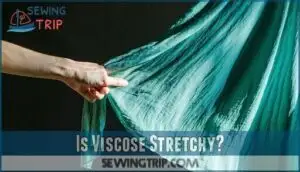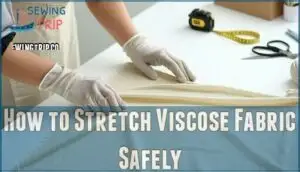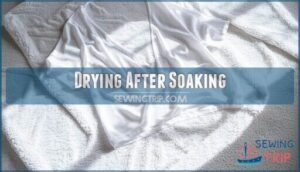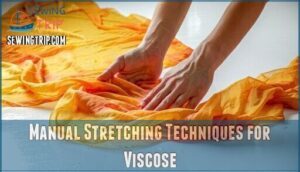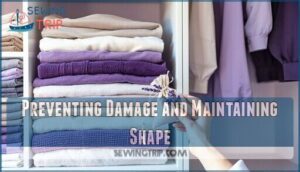This site is supported by our readers. We may earn a commission, at no cost to you, if you purchase through links.
 You spent hours searching for the perfect viscose dress, and it finally arrived—but it’s just a touch too snug across the shoulders. Before you box it up for a return, there’s good news: viscose can be stretched, though it requires a gentler touch than cotton or jersey knits.
You spent hours searching for the perfect viscose dress, and it finally arrived—but it’s just a touch too snug across the shoulders. Before you box it up for a return, there’s good news: viscose can be stretched, though it requires a gentler touch than cotton or jersey knits.
The fabric’s cellulose fibers relax when exposed to moisture and heat, allowing you to coax out a bit of extra room without causing permanent damage. Understanding the right techniques makes all the difference between successfully resizing your garment and ending up with a warped, misshapen mess.
With the proper soaking methods, manual reshaping, and controlled heat application, you can safely stretch viscose up to half a size larger while preserving its signature drape and softness.
Table Of Contents
- Key Takeaways
- What is Viscose Fabric?
- Is Viscose Stretchy?
- How to Stretch Viscose Fabric Safely
- Soaking Method to Stretch Viscose
- Manual Stretching Techniques for Viscose
- Using Heat to Stretch Viscose
- How Much Can You Stretch Viscose?
- Viscose Blends for Extra Stretch
- Preventing Damage and Maintaining Shape
- Frequently Asked Questions (FAQs)
- Conclusion
Key Takeaways
- Viscose can be stretched up to half a size larger using moisture and heat to relax its cellulose fibers, but pure viscose only stretches about 2% before permanent deformation occurs and lacks the fiber memory to bounce back.
- The safest stretching method involves soaking the garment in lukewarm water with baby shampoo or conditioner for 15-30 minutes, then gently pulling while damp and air-drying flat to lock in the new shape.
- Viscose blends with spandex or elastane (5-15%) offer significantly better stretch and recovery than pure viscose, making them ideal for fitted garments while maintaining the fabric’s signature drape and softness.
- Overstretching viscose causes irreversible damage, including fiber weakness, shape distortion, and texture changes, and hot water or high heat should always be avoided as they trigger 10-20% shrinkage and permanent fiber damage.
What is Viscose Fabric?
Before you can stretch viscose, you need to understand what you’re working with. Viscose is a semi-synthetic fabric with unique properties that affect how it reacts to stretching techniques.
Let’s look at where it comes from, what makes it special, and the different types you might encounter.
Origin and Manufacturing Process
Back in the 1880s, Hilaire de Chardonnet created the first artificial silk, and by 1891, a British team patented the viscose manufacturing process using wood pulp cellulose, sodium hydroxide, and carbon disulfide.
Today, viscose production reaches over 8 million metric tons annually, with China leading global output. This semisynthetic material starts with cellulose sourcing from spruce, pine, or eucalyptus trees, then undergoes chemical processes that transform pulp into the silky fabric you see in stores. The process often incorporates sustainable forest sourcing for raw materials.
Key Properties and Characteristics
Once the cellulose goes through this chemical transformation, it emerges with a unique set of qualities that make it stand out on the rack. Viscose fabric properties like its softness and drape create a silk-like feel that flows beautifully. The breathability keeps air moving, while its absorbency pulls moisture away from your skin.
That’s the trade-off, though—viscose fabric elasticity is minimal since fiber elasticity wasn’t built into its structure. This moisture sensitivity means the fabric can lose shape when wet, limiting its natural stretch.
Types of Viscose Fabrics
Manufacturers have found ways to tweak viscose’s formula, creating different versions that suit specific needs—from sheer knits to blends with added stretch. Here’s what you’ll find:
- Viscose Jersey – A lightweight knit with a soft drape, perfect for casual wear
- Cuprammonium Rayon – Made with ammonia for extra smoothness and durability
- Slinky Viscose – Blends acetate for better flow and stretch
- Polyester Viscose – Combines wrinkle resistance with breathability
- Viscose Elastane – Adds spandex to boost stretchability up to 30%
Each type adjusts viscose fabric properties to match different garment needs.
Is Viscose Stretchy?
If you’ve ever tugged on a viscose garment and wondered why it won’t budge, you’re not alone. Viscose behaves differently than fabrics you might be used to, and understanding its natural properties helps you work with it rather than against it.
Let’s look at what makes viscose tick with respect to stretch, why it resists movement, and how it stacks up against other fabrics.
Natural Elasticity of Viscose
If you’ve ever tugged at a viscose garment hoping it would give a little, you’ve likely discovered that this silky fabric doesn’t stretch the way cotton or jersey does. That’s because viscose’s fiber structure is built from rigid cellulose properties, which naturally lack the elongation and resilience found in elastic materials.
The weave impact also plays a role—viscose fabrics are usually woven tightly, limiting rebound. Moisture influence can temporarily soften fibers, but the elasticity of viscose remains minimal overall, making viscose fabric stretchability quite limited compared to stretch-friendly textiles.
Why Viscose Lacks Stretch
While many fabrics bounce back after being pulled, viscose doesn’t budge much—and the reason lies in how cellulose molecules bond together during manufacturing. The molecular arrangement creates rigid, parallel chains without natural coiling, so there’s nothing to snap back into place.
Unlike spandex or knit fabrics, viscose’s weave impact locks fibers tightly together, and the absence of resilience means once stretched, the fabric stays that way—losing its original shape rather than recovering elasticity.
Viscose Vs. Other Stretch Fabrics
When comparing stretch fabrics, you’ll notice viscose falls short against most alternatives—but understanding these differences helps you choose the right material for your needs.
- Spandex vs. Viscose: Spandex stretches 400–500% and recovers 99% of its shape, while pure viscose stretches only 2% with virtually no recovery.
- Nylon vs. Viscose: Nylon offers 30% stretch and greater durability, making it better for performance wear than viscose’s minimal elasticity.
- Polyester vs. Viscose: Polyester maintains shape better and resists shrinkage, though viscose absorbs moisture more effectively for comfort in hot weather.
- Blend Durability: Viscose-spandex blends (usually 95/5) stretch 20%+ and combine softness with elasticity—ideal for body-conscious clothing. Viscose is a semi-synthetic fabric derived from wood pulp.
- Comfort Comparison: Viscose excels in drape and breathability for elegant garments, but spandex-blended options deliver stretch without sacrificing that silky feel.
How to Stretch Viscose Fabric Safely
Stretching viscose requires care and the right approach, as this delicate fabric can easily lose its shape or get damaged. Before you begin, you’ll want to prepare the fabric properly and know what to avoid.
Let’s look at the key steps to keep your viscose safe while stretching it.
Preparing Viscose for Stretching
Before you start tugging at your viscose garment, you need to get it in the right condition—think of it like warming up before a workout to prevent injury. First, check the care label to understand any special requirements. Then, prepare the fabric by gently washing it with a mild detergent in cold water—this gentle washing helps with fiber relaxation and moisture absorption, making viscose fabric more pliable for stretching fabric techniques.
| Preparation Step | Purpose | Temperature Control |
|---|---|---|
| Wash with mild detergent | Fabric softening and removing stiffness | Cold water only |
| Keep fabric damp | Boosts moisture absorption for easier stretching | Room temperature |
| Avoid wringing or twisting | Prevents damage during viscose shrinking and stretching | N/A |
Keep the garment damp throughout the process, as dry viscose resists stretching and risks tearing.
Precautions to Avoid Damage
Stretching viscose is a bit like managing a delicate piece of wet paper—one wrong move, and you’ll end up with tears, distortion, or permanent damage. Always avoid harsh chemicals and hot water, which accelerate fabric damage and shrinkage. Keep temperature considerations in mind—cold water protects the fibers, while high heat causes fiber breakage.
Never wring or twist viscose fabric, as this distorts the weave permanently. Use gentle drying techniques by laying garments flat on towels rather than hanging them, which prevents stretching fabric unevenly.
For storage solutions, keep viscose in cool, dry places to maintain its structure and prevent shrinkage over time.
Soaking Method to Stretch Viscose
Soaking viscose in water is one of the gentlest ways to relax its fibers and make stretching easier. Adding baby shampoo or conditioner to the process helps soften the fabric even more, creating better conditions for reshaping.
Here’s how to use this method safely and effectively.
Using Baby Shampoo or Conditioner
Baby shampoo and hair conditioner work like a gentle massage for stiff viscose fibers, coaxing them to relax and become more pliable. These products soften the cellulose structure without harsh chemicals, making them ideal for stretching fabric back to shape or restoring shrunken clothing.
Mix one tablespoon of baby shampoo or hair conditioner per gallon of lukewarm water, ensuring you rinse thoroughly afterward to remove residue.
Step-by-Step Soaking Instructions
Once your shampoo solution is ready, the actual soaking process requires just a few careful steps to protect your viscose while coaxing it into a more flexible state. Submerge your garment completely in the room temperature water mixture, letting it soak for 15 to 30 minutes—longer immersion times allow deeper fiber relaxation.
Gently squeeze the fabric periodically to help the solution penetrate the weaving, but never wring or twist, as viscose is vulnerable when wet.
Drying After Soaking
After the soak, how you dry your viscose makes all the difference between a perfectly stretched piece and a warped mess.
Follow these drying methods to preserve your work:
- Roll in a dry towel to absorb excess water—never wring or twist the fabric.
- Lay flat on a clean surface to maintain shape while air drying naturally.
- Avoid direct sunlight and heat sources that could cause uneven shrinkage.
- Allow 12-24 hours for complete drying before wearing or storing.
Manual Stretching Techniques for Viscose
Once your viscose is wet and ready, it’s time to do the actual stretching. The key is working slowly and carefully so you don’t damage the delicate fibers.
Here’s how to manually stretch viscose using your hands, some patience, and a few household items.
Stretching When Wet
When viscose is wet, the fibers loosen their grip and become more willing to cooperate with your reshaping efforts. This is when fiber relaxation is at its peak, making wet reshaping the perfect time to stretch viscose fabric gently. Baby shampoo benefits include softening fibers even more during soaking. Use gentle pulling motions to avoid damage while applying fabric stretching techniques.
| Factor | Impact on Stretching |
|---|---|
| Water Temperature | Cold water prevents shrinkage; lukewarm relaxes fibers |
| Fiber Condition | Wet fibers stretch 2-3x easier than dry |
| Drying Impact | Air drying maintains new shape; heat reverses stretch |
Gentle Pulling and Reshaping
Now comes the part where your hands do the work—applying just enough tension to coax the fabric into its new shape without crossing the line into damage. Use gradual stretching with consistent tension, pulling gently from the center outward to maintain even fabric pull.
This approach preserves shape while avoiding distortion. Work slowly, checking your progress every few pulls, and remember that viscose fabric responds best to patience rather than force when using these fabric stretching techniques for proper fabric care.
Using Towels and Flat Surfaces
A dry towel on a flat surface becomes your stretching workstation, giving you the stability and support you need to reshape viscose without tearing it.
Here’s how to set up your workspace for successful gentle stretching:
- Towel absorbency pulls excess moisture from the fabric while you work
- Use a flat surface like a table or counter for even pressure distribution
- Pin or weight down edges when reshaping garments to hold your desired dimensions
- The towel acts as a fabric stretcher, gripping the viscose during drying techniques
This method keeps stretchy fabric stable while you coax viscose fabric into shape, making stretching rayon garments manageable and controlled.
Using Heat to Stretch Viscose
Heat can be a helpful ally when you’re trying to coax a bit more give out of viscose fabric. The warmth works to relax those stiff cellulose fibers, making them more pliable and easier to reshape.
Let’s look at three practical heat-based techniques you can use safely at home.
Ironing for Fiber Relaxation
Heat works like a gentle massage for stiff fabric fibers, and your iron is the perfect tool to coax viscose into a more relaxed state. Set your iron to a low heat setting—viscose fabric can’t withstand high temperatures without damage.
Lightly spray the garment with water before ironing to help fiber softening and prevent scorching. Press gently without applying too much pressure, working in the direction of the weave to maintain proper fiber alignment while relaxing wrinkles.
Steaming Techniques
Steaming takes the relaxation process even further by surrounding viscose fibers with moisture-rich warmth that penetrates deeper than a simple iron press.
Hold your garment steamer about two inches from the viscose fabric and move it slowly across the surface. The steam temperature should remain gentle—too hot and you risk fiber damage.
After steaming each section, gently stretch the fabric while it’s still warm and pliable, then lay it flat to cool and set in its new shape.
Spray and Stretch Method
If you’re short on time or working with a smaller garment, the spray and stretch method offers a quick, targeted approach that skips the full soaking process. Fill a clean spray bottle with cool water and lightly mist the viscose fabric until damp—not soaked. This spray application permits fiber relaxation without oversaturating.
Once moistened, gently stretch the fabric in the desired direction:
- Use both hands to pull slowly from the center outward
- Work in small sections for better shape preservation
- Avoid aggressive tugging that causes fabric shrinkage or tears
- Check progress frequently to prevent overstretching
- Let the garment air-dry flat to lock in your adjustments
This drying technique helps maintain the stretch you’ve achieved.
How Much Can You Stretch Viscose?
You’ve tried the water method and maybe even used some heat, but there’s a ceiling to what viscose can actually do. The fabric won’t stretch indefinitely, and pushing it too far can cause permanent damage.
Let’s look at what influences how much give you can get and where the danger zone begins.
Factors Affecting Stretchability
Several elements determine how much you can stretch viscose fabric. Fiber Composition plays the primary role—pure viscose only stretches about 2% before losing its shape, while blends with elastane can stretch up to 400%. Blend Proportions directly control stretch—adding just 5–10% spandex increases stretch fabric performance by 3–10 times.
Fabric Construction matters too, since knitted viscose offers 2–5 times more elasticity than woven types. Moisture Effects are significant; wet viscose becomes 30–50% weaker and more pliable, allowing temporary reshaping but risking permanent distortion.
Limitations and Risks
Stretching viscose is like walking a tightrope—you risk more than you gain. Pure viscose offers minimal elasticity and lacks the fiber memory to bounce back after manipulation. Here’s what can go wrong when you push the limits:
Stretching viscose is precarious—pure viscose barely stretches and won’t recover, risking permanent damage rather than gaining flexibility
- Irreversible Damage – Viscose stretches only about 2% before permanent deformation occurs, with no reliable recovery after washing.
- Shrinkage Risks – Heat or water exposure after stretching can cause 10–20% shrinkage in untreated garments.
- Wet Weakness – Viscose loses up to half its strength when wet, raising the risk of tearing during manipulation.
- Texture Changes – Overstretched areas develop puckering, bagging, or altered sheen that’s difficult to reverse.
- Repair Limits – Restoration rarely succeeds; professional alteration usually requires recutting rather than recovery stretching.
Preventing shrinkage starts with understanding these textile damage patterns before attempting any stretching.
Viscose Blends for Extra Stretch
If pure viscose doesn’t give you the stretch you need, blended fabrics can be your best friend. Mixing viscose with elastic fibers creates fabrics that keep viscose’s soft feel while adding flexibility.
Let’s look at the most common blends and how they compare for stretch and performance.
Viscose-Spandex and Elastane
Blending viscose with spandex or elastane is like giving a smooth fabric a superpower—suddenly, it can move with you instead of against you. Adding just 5% spandex creates a viscose stretch fabric that drapes beautifully while offering stretch recovery. Higher spandex percentages increase elasticity, making these blends perfect for activewear applications where enhanced durability matters.
| Blend Ratio | Best Uses |
|---|---|
| 95% Viscose, 5% Spandex | Casual wear, dresses |
| 90% Viscose, 10% Elastane | Leggings, fitted tops |
| 85% Viscose, 15% Spandex | Activewear, sportswear |
Viscose-Nylon and Polyester Blends
While spandex brings stretch, nylon and polyester blends focus on adding strength and resilience to viscose’s naturally soft character. Nylon benefits include improved durability and elasticity, while polyester advantages center on wrinkle resistance and shape retention. These viscose-nylon blends and polyester viscose combinations work well when you need fabric that lasts.
- Viscose-nylon blend: Combines softness with nylon’s elasticity and abrasion resistance for long-lasting garments
- Polyester viscose: Offers wrinkle-free wear and maintains shape better than pure viscose
- Cost comparison: Nylon and polyester blends usually cost less than viscose-spandex options
- Ideal applications: Perfect for everyday wear, travel clothing, and pieces requiring blend durability
Comparing Blended Fabrics
Each blend offers its own set of trade-offs. Viscose-spandex blends deliver maximum stretch and recovery, making them ideal for activewear. Viscose-polyester comparison shows better wrinkle resistance, while viscose and nylon comparison highlights durability. A viscose-cotton blend feels breathable, viscose-linen mix stays crisp, and viscose-silk fusion drapes luxuriously.
Performance differences depend on your needs—cost comparison reveals spandex blends often run higher, but their stretch justifies the price for fitted garments.
Preventing Damage and Maintaining Shape
Once you’ve stretched your viscose to the right fit, you’ll want to keep it that way. The key is knowing how to wash, dry, and care for the fabric so it doesn’t shrink back down or lose its shape.
Let’s look at the best ways to protect your viscose garments and even fix them if something goes wrong.
Washing and Drying Tips
To keep your viscose looking its best—and prevent unwanted shrinkage or damage—you’ll need to treat it with a gentle touch from wash to dry.
Here’s how to care for viscose fabric properly:
- Water temperature and detergent choice: Always use cold water with a mild, pH-neutral detergent to protect the delicate cellulose fibers
- Washing instructions: Hand wash when possible, or use your machine’s delicate cycle to minimize agitation and stress on the fabric
- Drying clothes properly: Skip the dryer entirely—lay your garment flat on a clean towel or hang it on a padded hanger to air dry away from direct sunlight
These viscose fabric care methods and drying techniques will help preserve your garment’s shape and texture for years to come.
Avoiding Shrinkage and Overstretching
Even with the right washing and drying habits in place, viscose can still shrink or lose its shape if you’re not careful about water temperature, care, and storage. Hot water is the main culprit behind shrinking, so stick with cold water every time.
Gentle care during washing protects the fibers from stretching out. For shape retention, avoid wringing or twisting the fabric—these actions compromise fiber protection and lead to distortion.
Proper drying methods and temperature control are your best tools for preventing rayon shrinkage and preventing clothing damage altogether.
Restoring Shrunken Viscose Garments
When viscose shrinks in the wash, you don’t have to retire that favorite garment—you can gently coax it back to size with a little patience and the right technique. Clothing restoration starts with understanding shrinkage causes and applying fiber relaxation methods that work.
Follow these reshaping techniques for repairing shrunken garments:
- Soak your shrunken rayon garment in lukewarm water with baby shampoo for 15 minutes
- Lay the wet fabric flat on a towel and gently stretch from the center outward
- Use gentle stretching motions—pull slowly to avoid tearing the weakened fibers
- Pin the garment to shape on a blocking board if available
- Air dry completely flat to lock in the restored size and prevent re-shrinkage
This garment restoration process requires patience, but it’s often your best shot at saving a favorite piece.
Frequently Asked Questions (FAQs)
What climate or weather conditions impact the stretch of viscose?
Moisture acts like a key that unlocks viscose’s flexibility. Humidity softens fibers, increasing stretchability, while dry air makes fabric stiff.
Temperature extremes and sunlight exposure weaken elasticity over time. Seasonal changes affect how viscose reacts to stretching attempts.
Can you stretch viscose permanently or temporarily?
You can stretch viscose temporarily, but not permanently. The fabric’s fiber memory means it usually returns to its original shape over time.
Reversibility factors like washing can reset any stretching you achieve, limiting long-term shape retention.
Does stretching viscose affect its color or texture?
Have you noticed your favorite garment looking duller after stretching? Stretching viscose fabric can impact color alteration and texture changes if done improperly.
Excessive pulling may cause fiber damage and weave distortion, while dye stability remains generally intact with gentle techniques.
Proper care maintains your viscose’s original appearance and stretchability.
How to stretch viscose without washing it first?
You can achieve fiber manipulation through heat application. Steam the viscose garment or use a warm iron with a pressing cloth.
Gently pull the fabric while applying heat for spot stretching, creating targeted stretch without washing first.
Can you unshrink viscose after tumble drying?
Yes, you can often reverse tumble-dry damage and unshrink viscose fabric care through gentle fiber restoration. Soak the garment in lukewarm water with baby shampoo, then carefully reshape it while damp.
Heat effects from tumble drying weaken fibers, so professional cleaning services might help with severe shrinkage.
What happens if you overstretch viscose fabric?
Overstretching causes fiber damage and shape distortion in viscose fabric. The weaving weakens permanently, leading to irreversible changes that reduce the fabric’s elasticity and structural integrity.
Repair options are limited once the stretchability is compromised.
Conclusion
Like Cinderella’s glass slipper, the perfect garment shouldn’t require compromise. Now that you understand how to stretch viscose safely through soaking, manual reshaping, and controlled heat, you can rescue that almost-perfect piece hanging in your closet.
Remember that patience pays dividends—viscose’s cellulose fibers respond best to gentle persuasion, not force. Work incrementally, checking your progress after each session, and you’ll likely gain that needed half-size of room without sacrificing the fabric’s elegant drape or silky texture.

